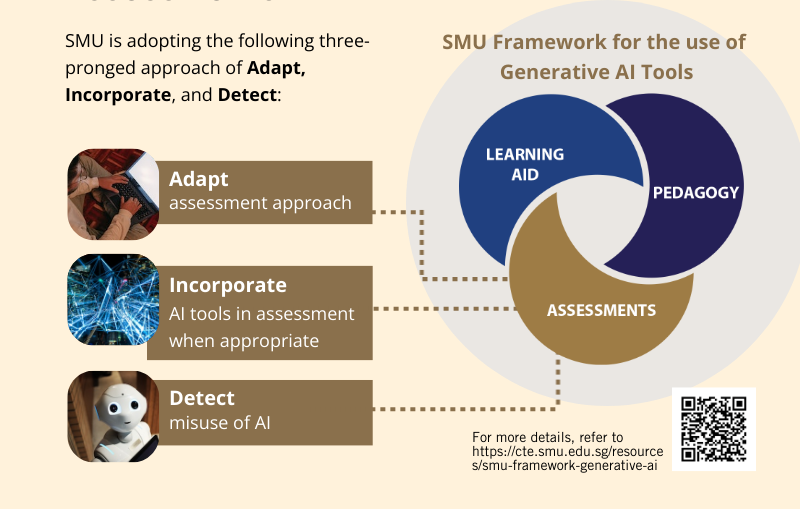| |
 |
 |
Since its introduction, Generative AI (GAI) tools have sparked new conversations on how it could be leveraged to enhance University teaching and learning. One area where instructors have been particularly keen to learn more about is GAI and its potential impact on assessment. This infographic provides some background and useful tips for SMU instructors, as well as information on how to prevent the misuse of these tools.
|
 |
 |
What is Generative AI?
|
| They are artificial intelligence applications that use deep learning algorithms to generate unique output that resembles human-created content. |
| These output include text, images, videos, and music. |
Examples of GAI tools include ChatGPT, MS Bing, Google Bard |
 |
 |
Maintaining Assessment Integrity
|
Concerns about GAI tools
in Assessment |
Assessment Types that are more vulnerable to GAI tools misuse |
Given the ability of GAI tools to generate unique responses, there are concerns that students may submit AI generated output as their own work, thus undermining the fair, honest and diligent pursuit of knowledge. This has the potential to erode academic integrity at SMU and pose a reputational risk. These generated responses may be difficult to distinguish and detect, even with the use of detection tools. |
Unproctored assessments , take home assignments, group projects. |
 |
 |
Assessment tasks that test lower order thinking skills such as recalling, defining, and describing certain concepts. |
|
Use of Generative AI Tools on Assessments
|
 |
Top Tips for Assessment Practices
|
| ADAPT |
 |
Shift emphasis to in-class assessments
- Conduct assessment under lock-down browser condition or pen & paper format
|
| |
|
 |
Redesign assessments beyond capabilities of AI tools
- Introduce authentic assessment which requires students to apply knowledge and skills in a practical or problem-solving context.
- If appropriate, complement and vary different forms of assessment. For example, focusing your grading more on Q&A after oral presentation.
|
|
| INCORPORATE |
 |
Clarify what is authorised and unauthorised use
- Have open and transparent discussions with students regarding the use of GAI in assessments.
- Students should be informed that any unacceptable use of generative AI tools will be considered a violation of the SMU Code of Academic Integrity.
|
| |
|
 |
Integrate Generative AI Tools into assessments
- Consider using the generative AI tools as a supplement to other forms of assessment. For example, ask students to critique or build on an AI generated response.
|
|
| DETECT |
 |
Only use AI Detection tool output as an indication for further investigation
- Instructors should prioritise the incorporation of generative AI tools in assessments and adapting of assessments over detection of its misuse.
|
| |
|
|
|
| |
|